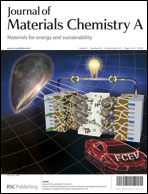Influence of intermolecular interactions of electron donating small molecules on their molecular packing and performance in organic electronic devices†
Abstract
Intermolecular interactions have a critical role in determining the molecular packing and orientation of conjugated polymers and organic molecules, leading to significant changes in their electrical and optical properties. Herein, we investigated the effects of intermolecular interactions of electron-donating small molecules on their structural, optical, and electrical properties, as well as on their performance in organic field-effect transistors (OFETs) and organic photovoltaics (OPVs). A series of dithienosilole-based small molecule donors were synthesized by introducing different terminal groups of ester and amide groups combined with three different versions of alkyl side chains. In comparison to dithienosilole-based small molecules with ester terminal groups, those with amide terminal groups exhibit strong intermolecular interaction by hydrogen bonding in a non-destructive manner. In addition, in order to control the intermolecular distance during assembly and thus fine-tune the interaction between the small molecule donors, three different alkyl side chains (i.e., n-octyl, n-decyl, and 2-ethylhexyl chains) were introduced into both small molecules with amide and ester terminal groups. The molecular packing and orientation of the small molecule donors were dramatically changed upon modifying the terminal groups and the alkyl side chains, as evidenced by grazing incidence X-ray scattering (GIXS) measurements. This feature significantly affected the electrical properties of the small molecules in OFETs. The trends in the activation energies for charge transport and the hole mobilities in OFETs were consistent with the molecular ordering and orientation propensity. In addition, the nano-scale morphology of small molecules blended with [6,6]-phenyl-C61-butyric acid methyl ester (PCBM) was also influenced by the intermolecular interaction of small molecule donors. Power conversion efficiencies of more than 4.3% in OPVs were obtained from dithienosilole-based small molecules with ester terminal groups and linear side chains due to the optimized intermolecular interaction and morphology of the active layer.


 Please wait while we load your content...
Please wait while we load your content...